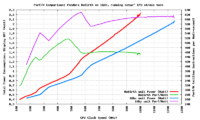I did some testing to compare the performance per Watt of my two Pandora units.
This was the setup: on both units, I ran notaz' CPU stress test (a NEON-intensive stress test that pretty much gives an upper bound on the CPU power consumption) for a big range of CPU frequencies. I closed the lids on both units, so we're not counting the display here (add about 0.5 Watt for the display at lowest brightness or 1 Watt at highest brightness), and also wifi and USB were disabled. The system bus speed was 360MHz on my ReBirth unit and 440MHz on my 1GHz unit (but I don't think that matters much here, because the CPU stress test is probably not RAM-intensive).

In the plot you can see the power consumption curves, and also the performance per Watt (that is, the number of instruction cycles that can be performed with one Watt-second of energy). As was expected, the 1GHz unit beats the ReBirth unit nicely, but it is nice to get this more accurate information.
You can clearly see the OPP change points in the perf/W curves. You can also read from this plot that, for example, a ReBirth unit at 800MHz consumes the same amount of power as a 1GHz unit at 1100MHz (both with 100% cpu use).
You can also see the ReBirth units are most efficient slightly below 500MHz, while the 1GHz units reach a peak just before 600MHz, and almost goes back to that same high perf/W above 1GHz.
This was the setup: on both units, I ran notaz' CPU stress test (a NEON-intensive stress test that pretty much gives an upper bound on the CPU power consumption) for a big range of CPU frequencies. I closed the lids on both units, so we're not counting the display here (add about 0.5 Watt for the display at lowest brightness or 1 Watt at highest brightness), and also wifi and USB were disabled. The system bus speed was 360MHz on my ReBirth unit and 440MHz on my 1GHz unit (but I don't think that matters much here, because the CPU stress test is probably not RAM-intensive).

In the plot you can see the power consumption curves, and also the performance per Watt (that is, the number of instruction cycles that can be performed with one Watt-second of energy). As was expected, the 1GHz unit beats the ReBirth unit nicely, but it is nice to get this more accurate information.
You can clearly see the OPP change points in the perf/W curves. You can also read from this plot that, for example, a ReBirth unit at 800MHz consumes the same amount of power as a 1GHz unit at 1100MHz (both with 100% cpu use).
You can also see the ReBirth units are most efficient slightly below 500MHz, while the 1GHz units reach a peak just before 600MHz, and almost goes back to that same high perf/W above 1GHz.

